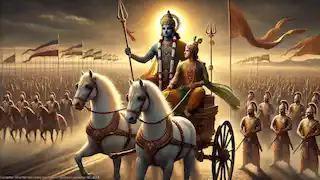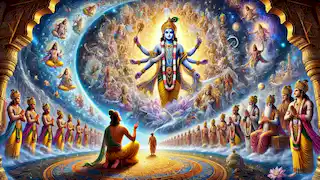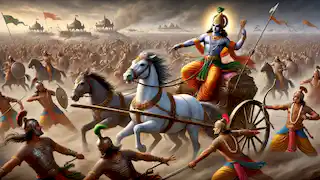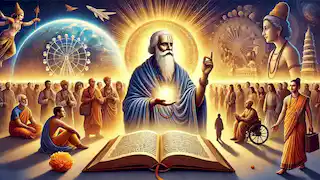The Bhagavad Gita
Reading time: 9 min

About this story: The Bhagavad Gita is a Myth from India set in the Ancient This Formal tale explores themes of Wisdom and is suitable for All Ages. It offers Moral insights. The sacred dialogue between Arjuna and Krishna on duty, wisdom, and the eternal soul.
The Bhagavad Gita is a sacred Hindu scripture, a part of the Indian epic Mahabharata, that unfolds as a dialogue between Prince Arjuna and the god Krishna. It is set on the battlefield of Kurukshetra, where Arjuna, a warrior prince, finds himself overwhelmed with doubt and moral confusion about fighting in the war against his own relatives, teachers, and friends. In this moment of existential crisis, he turns to Krishna, his charioteer, for guidance.
The Gita is not just a conversation about warfare, but a deep philosophical text that addresses the nature of life, duty, righteousness (dharma), the self, and the universe. It provides insights into the path of devotion, action, and knowledge, guiding individuals toward spiritual enlightenment.
The teachings of the Bhagavad Gita have transcended religious boundaries and have been revered by philosophers, leaders, and thinkers around the world. Its timeless wisdom continues to inspire people in their quest for truth, purpose, and peace.
The Dilemma of Arjuna
The battle of Kurukshetra was imminent. Two vast armies stood poised for combat, the Pandavas and the Kauravas, both prepared to engage in a war that would determine the fate of the kingdom. As Arjuna, one of the mightiest warriors of the Pandava army, looked across the battlefield, his eyes fell upon the familiar faces of his kin, his teachers, and his beloved friends. The sight overwhelmed him with sorrow and doubt.
“How can I fight against my own family, my revered teachers?” he thought. The weight of the war bore heavily on his heart. He lowered his bow, the Gandiva, and turned to Krishna, who was acting as his charioteer.
“Krishna, my mind is clouded with confusion. I see no good in this war, only destruction. How can I strike down those whom I have loved and revered for my entire life? I feel lost in this turmoil. Please guide me, for I am unable to see clearly.”
Krishna, embodying both the divine and the wise friend, smiled gently. He knew that Arjuna’s anguish was more than just reluctance to fight—it was a profound spiritual crisis. Arjuna, the warrior who had never known defeat in battle, was now confronting his deepest fears and uncertainties.
“Arjuna,” Krishna said, “why do you grieve over things that are transient? The soul is eternal; it is neither born, nor does it die. What you are seeing as life and death are mere appearances.”
Arjuna, still gripped by doubt, protested. “But Krishna, how can I kill my elders, my cousins, and my friends? It would be a sin to cause such harm. Even if they are wrong, I cannot justify violence.”
Krishna’s response would form the foundation of the Gita’s teachings.
The Nature of the Self
Krishna began explaining the eternal nature of the soul. “The soul, Arjuna, is immortal. It is not slain when the body dies. Just as a person discards worn-out clothes and wears new ones, the soul discards old bodies and takes on new ones. Therefore, you should not grieve for the living or the dead.”
Arjuna listened intently, but the conflict in his heart remained unresolved. He could not shake the feeling that fighting his kin was inherently wrong. He asked, “But Krishna, even if the soul is eternal, how can the actions I take in this life not have consequences? Wouldn’t killing my family bring me bad karma and lead me to ruin?”
Krishna smiled again, his eyes filled with compassion. “Arjuna, your confusion stems from a misunderstanding of action and duty. You are a Kshatriya, a warrior, and it is your duty to fight in this war for righteousness. Action, when performed without attachment to the results, does not bind one in the cycle of karma. What matters is not the outcome, but the purity of intent and the dedication with which you fulfill your duties.”
Arjuna was puzzled. “How can I act without being attached to the results?”
Krishna explained the path of selfless action, or Karma Yoga.
Karma Yoga – The Path of Selfless Action
“Arjuna,” Krishna continued, “the world is sustained through action. Even I, the Supreme Being, continue to act, though I have nothing to gain. You, too, must act, but without attachment to the fruits of your labor. When you act without desire for personal gain, you transcend karma.”
This principle, known as Karma Yoga, teaches that one should focus on the action itself, not on what the action will bring. By doing so, one remains free from the binding effects of karma and can lead a life of inner peace and fulfillment.
Krishna encouraged Arjuna to see beyond the immediate consequences of the battle. “You must fight, not because you desire victory, but because it is your duty to uphold righteousness. Surrender the fruits of your actions to me and remain detached.”
Arjuna, still struggling to reconcile his heart and mind, asked, “But Krishna, is there no other path besides action? What about knowledge? Can one not attain liberation through wisdom alone?”
This question led Krishna to introduce another path.
Jnana Yoga – The Path of Knowledge
Krishna began to explain the importance of knowledge and wisdom in understanding the true nature of reality.
“Indeed, Arjuna, knowledge is essential. Through wisdom, one can see the unity of all things. The wise see no difference between a learned scholar, a cow, an elephant, or even a dog. They understand that the soul within all beings is the same.”
This path of Jnana Yoga involves the pursuit of knowledge to transcend ignorance and realize the ultimate truth. By cultivating wisdom, one can overcome the illusions of the material world and see the divine in everything.
However, Krishna cautioned that knowledge without action is incomplete. “True wisdom leads to selfless action. Even the wise act in the world, performing their duties while remaining detached.”
Arjuna began to grasp the significance of Krishna’s words. But there was still another aspect of spiritual practice that Krishna wanted him to understand.
Bhakti Yoga – The Path of Devotion
Krishna spoke of Bhakti Yoga, the path of devotion to God.
“Arjuna, the greatest of all paths is devotion. When one surrenders to me fully, with love and devotion, I take care of all their concerns. The devotee who constantly remembers me, who sees me in all things, and who offers their heart to me is most dear to me.”
Through Bhakti, one can develop a personal relationship with the divine and find peace in the surrender of the ego. It is the path of love, where the devotee’s actions, thoughts, and words are offered in service to God.
Krishna’s words filled Arjuna’s heart with hope and clarity. The weight of his doubts began to lift as he realized that his inner conflict was not about the battle itself, but about understanding his role in the larger cosmic order.
The Vision of the Universal Form
As Arjuna’s mind became more receptive to Krishna’s teachings, Krishna revealed his true divine form to him. Arjuna saw Krishna not as his charioteer but as the Supreme Being, encompassing the entire universe within his infinite form.

This vision overwhelmed Arjuna with awe and reverence. He saw the entire cosmos—the past, present, and future—unfold before him. He saw all beings, from the smallest creatures to the greatest gods, as part of Krishna’s divine body.
Arjuna, trembling with both fear and wonder, said, “O Lord, I see the entire universe within you. You are the creator, sustainer, and destroyer of all. How can I comprehend your vastness?”
Krishna, in his universal form, replied, “What you see is but a fraction of my true nature. I am beyond all that you can perceive, yet I am within all things. I am the source of everything, and I pervade the entire creation.”
This vision further deepened Arjuna’s understanding of his duty and the nature of the universe.
Surrender and Liberation
Having seen Krishna’s divine form, Arjuna’s doubts were finally dispelled. He realized that the battle of Kurukshetra was not merely a physical war, but a symbol of the eternal struggle between righteousness and unrighteousness.
Arjuna said, “Krishna, you have shown me the path. I understand now that my duty is to fight, not for personal gain, but to uphold the eternal law of dharma. I surrender myself to your will. Please guide me.”
Krishna, pleased with Arjuna’s surrender, assured him, “Do not fear, Arjuna. Those who walk the path of righteousness, with faith and devotion, are always protected by me. Perform your duties without attachment, and you will attain liberation.”
The Battle Begins
With his doubts resolved and his heart filled with Krishna’s teachings, Arjuna picked up his bow, Gandiva, once again. His mind was clear, his purpose renewed. The great battle of Kurukshetra began.

As the armies clashed, Arjuna fought with a sense of detachment, no longer concerned about victory or defeat. He fought not for himself, but for the cause of righteousness.
The teachings of the Gita continued to guide him throughout the battle. He remained centered in his devotion to Krishna, performing his duty as a warrior without attachment to the results.
The Legacy of the Gita

The Bhagavad Gita’s teachings extend far beyond the battlefield. Its message of self
less action, devotion, and wisdom resonates with people of all backgrounds and beliefs. It addresses the eternal human quest for meaning, purpose, and inner peace.
The Gita’s influence has spread across centuries and continents. It has inspired great leaders like Mahatma Gandhi, who found in it the strength to lead a non-violent struggle for India’s independence. Philosophers, scholars, and spiritual seekers have all turned to the Gita for guidance in their personal and professional lives.
In the modern world, the Gita’s teachings remain as relevant as ever. Its message encourages individuals to live with integrity, to fulfill their duties with a sense of purpose, and to seek the divine within themselves and others.
Conclusion – The Eternal Wisdom

The Bhagavad Gita is more than just a scripture; it is a timeless guide to living a life of purpose, peace, and fulfillment. Through its teachings, we learn that life is a journey, and our ultimate goal is to realize our true nature as eternal souls.
By following the paths of knowledge, action, and devotion, we can overcome the illusions of the material world and attain spiritual liberation.
The Gita reminds us that no matter the challenges we face, we are never alone. The divine is always with us, guiding us, protecting us, and leading us toward the ultimate truth.


















